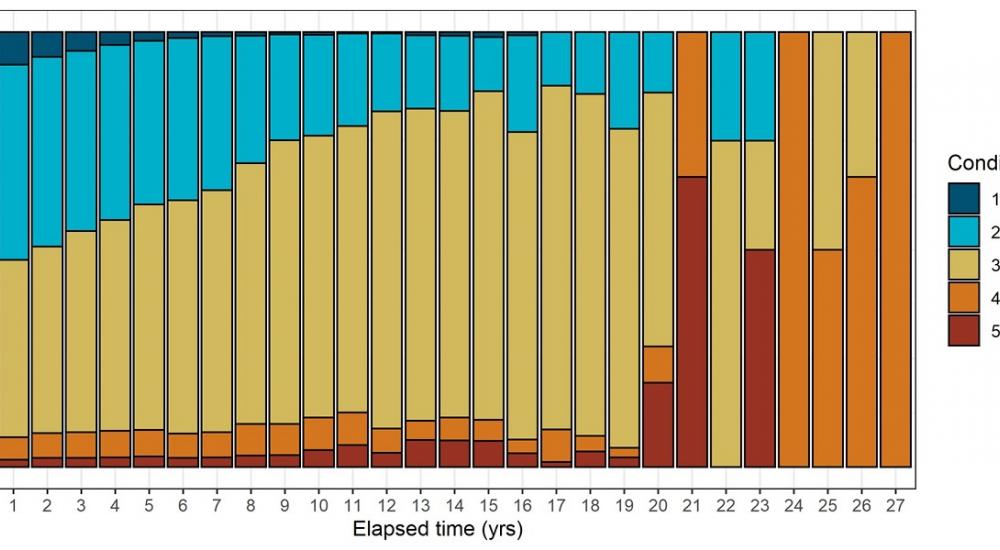Flood protection approach draws on statistical method from medicine
Our experts have developed an innovative scientific approach to evaluating the need to repair, maintain or replace flood defences and structures, helping improve vital protection to people and properties from flooding and erosion.
The team completed the work to support the Environment Agency in its planning for investment in flood and coastal risk management assets, such as embankments, walls, culverts and screens. By referring to a statistical method known as survival analysis protection, used extensively in medical research, our engineers and statisticians established a novel approach to calculating deterioration to flood assets.
Using the new method, the team updated deterioration curves, which are key to showing how the condition of an asset deteriorates with time from the best to the worst condition. Deterioration depends on factors such as asset type, environment and the load experienced. Asset managers need to understand the likely deterioration rates across the asset stock to gauge when appropriate interventions are most effective for maintenance, repair and replacement, ensuring that they will continue to provide the required protection.

“Existing deterioration curves were developed using historic data, targeted monitoring and expert input from practitioners – for a range of asset types, maintenance regimes, environmental conditions and loading,” explains HR Wallingford Principal Engineer Marta Roca. “However, due to the uncertainties associated to these processes, we took a completely different approach: we developed a complete statistical approach to address the fundamental question: how long can an asset last until it deteriorates to the next condition grade?”
The mathematical formulation of the question, as well as its solution, falls within the domain of a branch in statistics called survival analysis. In clinical trials, the ultimate objective is to understand the probability of a patient surviving (up to a given period of time) under various possible conditions and interventions.
More recently, the application of survival analysis has broadened to reliability theory and analysis in engineering, duration analysis and modelling in economics, and event history analysis in sociology. By referring to the well-established system of survival analysis theory and methodology, our team was able to propose a scientific approach that is backed by decades of theoretical development from statisticians and experts from other fields, implemented on the domain-specific database on asset deterioration.
Ye Liu, our Principal Statistician, explains “This is a perfect example of uncovering critical insights in a highly specialised domain of engineering using statistical analysis. The data science team is always keen to support our colleagues in all lines of business to decipher complicated datasets.”
The HR Wallingford team made use of Environment Agency databases that contain asset assessment records for 25 different types of defences and structures (with more than 240,000 condition survey records) spanning over more than 20 years.
“Existing deterioration curves were developed using historic data, targeted monitoring and expert input from practitioners – for a range of asset types, maintenance regimes, environmental conditions and loading,” explains HR Wallingford Principal Engineer Marta Roca. “However, due to the uncertainties associated to these processes, we took a completely different approach: we developed a complete statistical approach to address the fundamental question: how long can an asset last until it deteriorates to the next condition grade?”
The mathematical formulation of the question, as well as its solution, falls within the domain of a branch in statistics called survival analysis. In clinical trials, the ultimate objective is to understand the probability of a patient surviving (up to a given period of time) under various possible conditions and interventions.
More recently, the application of survival analysis has broadened to reliability theory and analysis in engineering, duration analysis and modelling in economics, and event history analysis in sociology. By referring to the well-established system of survival analysis theory and methodology, our team was able to propose a scientific approach that is backed by decades of theoretical development from statisticians and experts from other fields, implemented on the domain-specific database on asset deterioration.
Ye Liu, our Principal Statistician, explains “This is a perfect example of uncovering critical insights in a highly specialised domain of engineering using statistical analysis. The data science team is always keen to support our colleagues in all lines of business to decipher complicated datasets.”
The HR Wallingford team made use of Environment Agency databases that contain asset assessment records for 25 different types of defences and structures (with more than 240,000 condition survey records) spanning over more than 20 years.
Want to know more?
